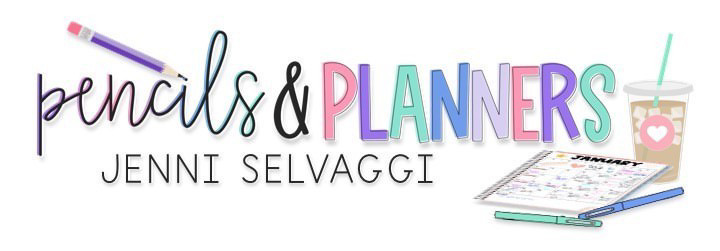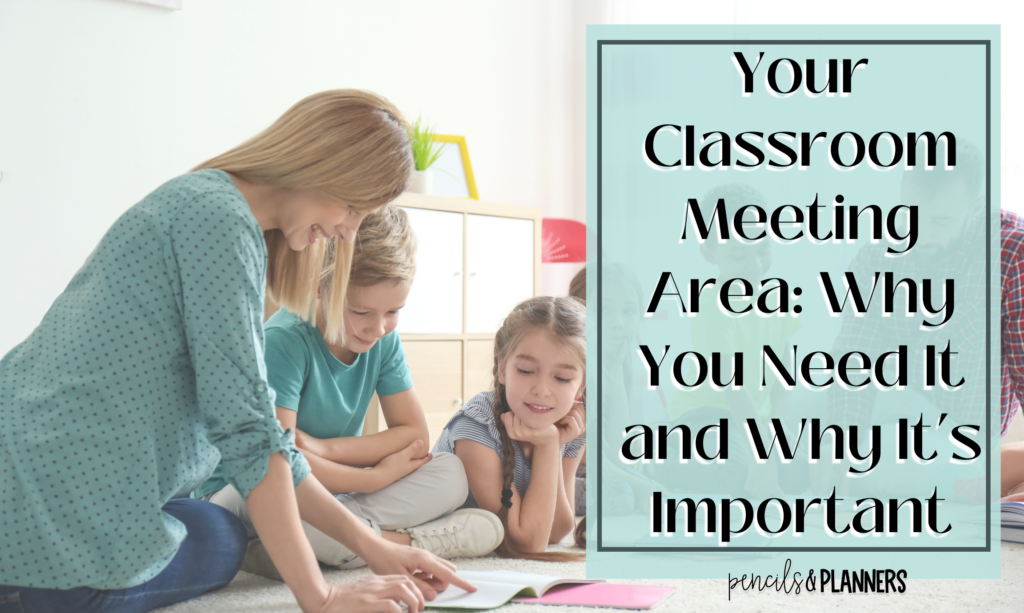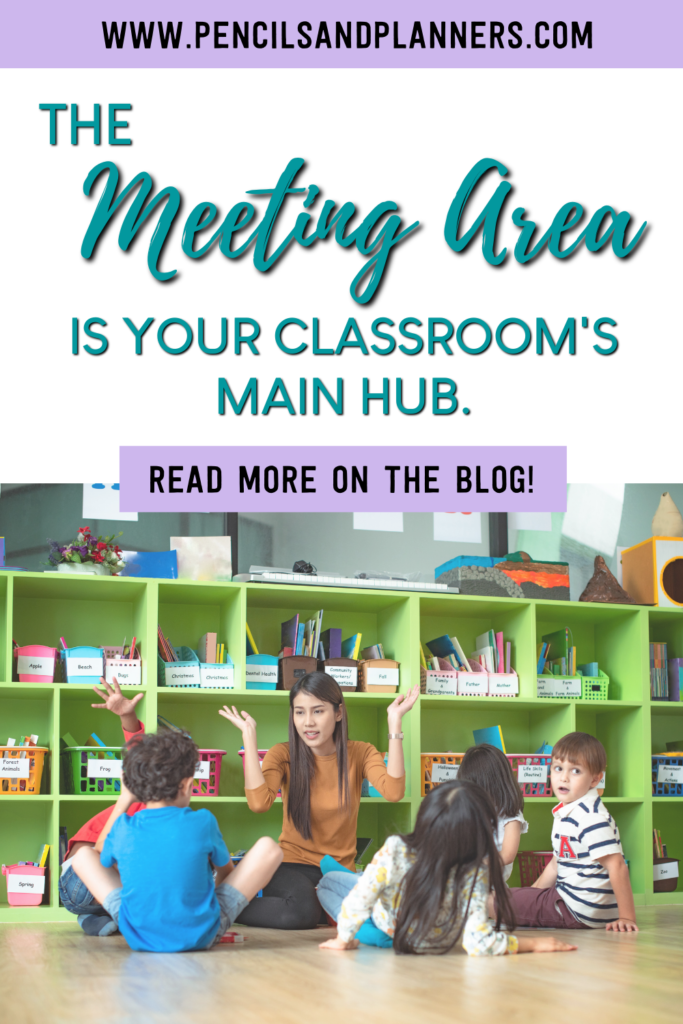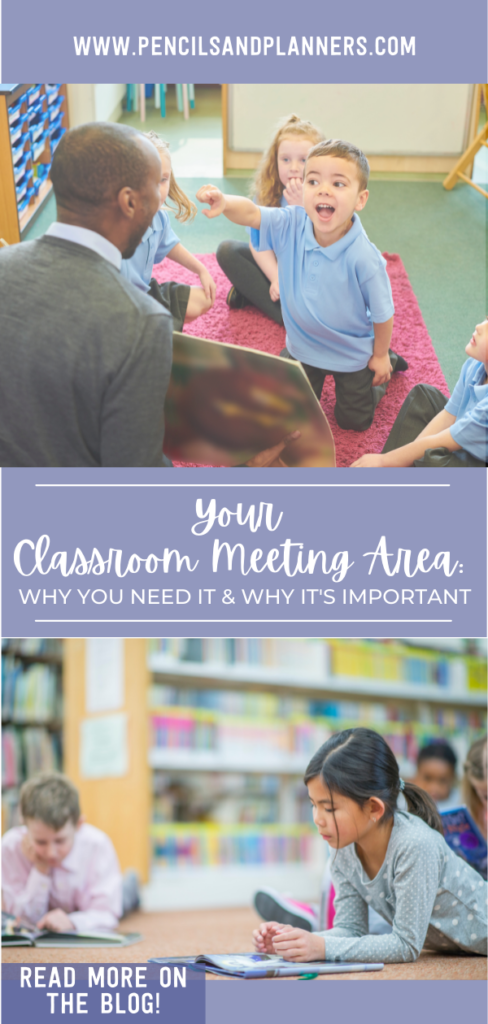Ever wondered why you need to carve out a space for your classroom meeting area? Are you working with a very tight space and trying to be strategic in using the space you have to work with? No matter the room size, being strategic with your classroom setup is important. But why the push to set up your classroom around a meeting area?
In this blog post, we’ll discuss:
- what your meeting area is
- its purpose
- setting up your meeting area, and
- the benefits of having and using your meeting area
For more support in having a successful school year, grab the ultimate guide here!

When I first started teaching, my classroom had a large 8ft x 13 ft rug in the classroom, 90% of the classrooms did. It gave the school a very consistent look and it gave students a great area to sit while they participated in the lesson. I became “stuck” on the idea that I NEEDED to have a rug. I HAD to have all 32 of my students sitting in front of me, the board, or the easel during my lessons. Imagine how overwhelmed and anxious I was when I returned one summer to set up and the rug had been trashed! There had been a water leak and it was ruined. I wasn’t the only teacher but I also wasn’t in the position to purchase a new one. This unexpected situation forced me to be CREATIVE!
Over the next few years, I realized (without a rug) that the meeting area was SO MUCH MORE than close proximity to the teacher and the lesson. The meeting area was not just convenient for all. And it definitely was not just “the right thing to do” or something I “had to do.” If you’ve been unsure if you really need a meeting area, check out the deets below on having a classroom meeting area.
Classroom Meeting Area
I consider the meeting area the main hub in my classroom. Yes, the meeting area brings the students closer to the teacher and the teacher’s materials during a lesson BUT it also brings the class together as a community. They are able to easily participate in academic discourse, share ideas, and ask questions. Through this gathering, the class builds their relationships and trust in taking risks academically, socially, and emotionally.
Your meeting area doesn’t have to be any one thing like a carpet. Your meeting area just needs to be a designated space that is used by you and your students. Encourage and allow your students to use the meeting area throughout the day (not just during your lessons). I mean, if you have the space (or better yet – if you’ve made some sort of space for the meeting area) get the biggest bang for your buck for that real estate by using it!
First, when identifying the best place to have your meeting area, think about:
- its purpose
- the materials you’ll need nearby (like calendar or place value blocks for the number of the day)
- grade-level of your students and whether they will all be at the meeting area on the floor
When I taught fourth grade, I had a much different set-up than when I taught first graders. My fourth graders were a lot taller than my littles haha – so be sure to consider how they can all sit comfortably.! Will your students be transitioning to and from the meeting area multiple times a day? And if so, move around the room to be sure that you have clear paths for movement to the meeting area.
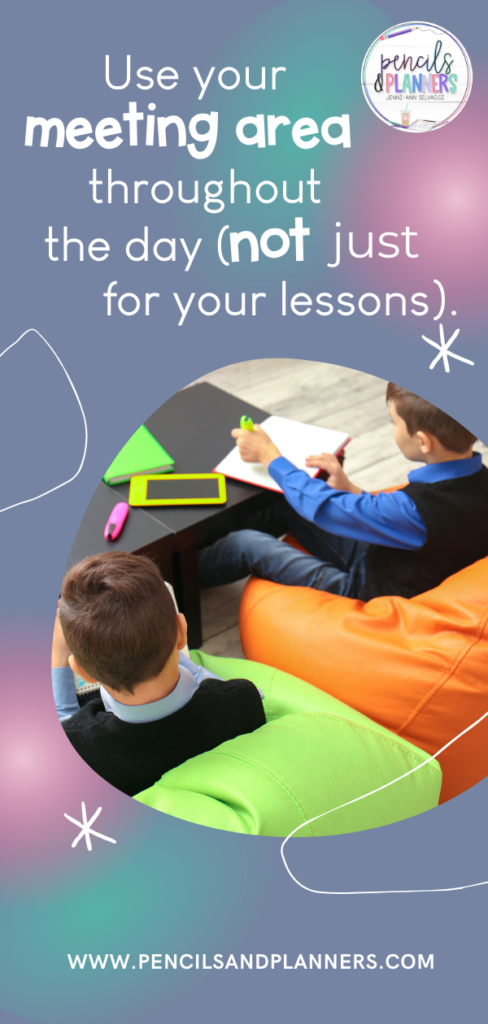
No Rug? No problem!
A large rug isn’t necessary. Nowadays there are a variety of seating arrangements for classrooms. But guess what? Your floor is ENOUGH. Need to provide clear boundaries (like my first graders needed)? You can use masking tape to give your students their own space.
Can you add a small sofa by your class library and meeting area for some cozy seating? Sure, but please don’t go buying furniture for your classroom! Remember that all items will need to be cleaned and maintained. (Here’s a downside to a rug… When a kid threw up and didn’t make it to the bathroom, guess where it usually landed. Yep, right on the rug.) If you have your heart set on flexible seating, reach out to administration and related service providers to see what may be available in your school. There are also options like Donor’s Choose to help with funding flexible seating for your class. Here are some ideas to get the creativity floating on what’s can be used or is available for use in the classroom:
- Foam puzzle piece squares
- Carpet samples
- Plastic Spot Markers
- Kids Beanbags
- Blow up chairs or yoga balls
- Round Floor Cushions
- Stackable Stools
- Portable Lap Desk (a personal favorite)
- Scoop Rocker Seats
- Wobble Stools (which are great for students that need to move)
Teachers – what about you?
Make sure you have seating arrangements for you at the meeting area. For instance, depending on the activity, you may sit on the rug with your students or you may need to be a little elevated so everyone can see work you’re modeling or see pictures in a book. Have your materials prepared and in a bin, along with your easel or board, any markers, pencils, or post-its that you might use. If you need your equity sticks and chart paper, keep those close by the meeting area too! You want to avoid having to get up and roam around the room gathering materials.
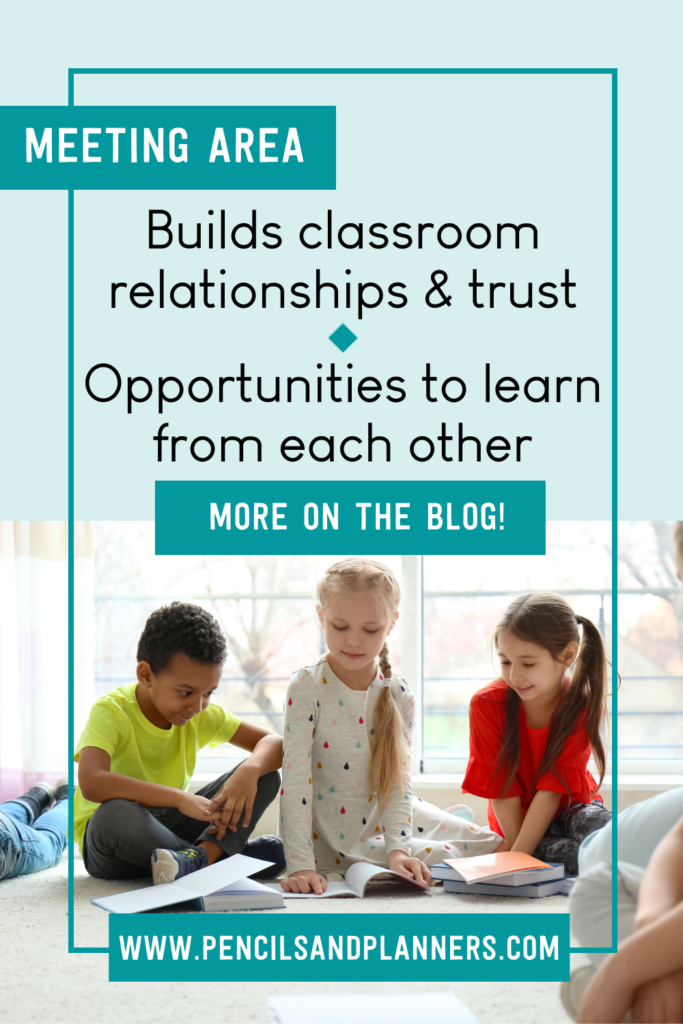
Classroom Community Building
Yes, meeting areas promote building classroom relationships and trust. Students are getting an opportunity to learn from each other. Sitting within their learning setting, amongst their peers and close to the teacher, encourages more engagement and improved focus.
A meeting area shouldn’t only be used during morning meetings or during lessons. Allow students to read at the meeting area, work on group projects, or work independently. The meeting area could even be utilized as a station during rotations. And it can be used as an area to gather in celebration! A lot of learning and growth happens throughout the school year – academically and personally! Recognize and honor this throughout the year (and what better place to come together than the meeting area)!
PRO TIP: Be flexible. (This is two-fold.)
- Sometimes students may not want to sit at the meeting area. There could be a multitude of reasons. Respect the decision (as long as the student continues to participate and complete their work).
- Your class will be different from year-to-year. It’s just the nature of personalities and dynamics. Sometimes your class dynamic will shift mid-year (it sounds scarier than it is). Don’t be tied down to how you have your meeting area set up. Tweak it if you need to. For example, if your meeting area is adjacent to the classroom library and your students are becoming distracted, adjust seating arrangements or reposition the meeting area.
There is no right or wrong. Find what works for you and your students, As long as those two things are on point (and safety, of course) – the learning and fun will be there!
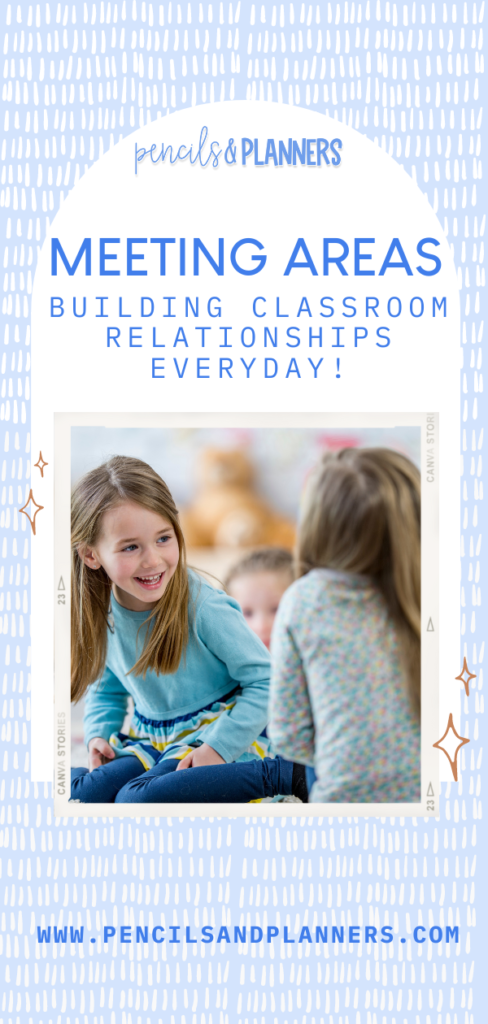
Benefits of Meeting Areas
We now know that meetings areas are great for lessons, group conversations, various activities but maybe you are trying to really dig deep and find a list of the benefits of a meeting area. Look no further!
Coming together at the meeting area can:
- change the climate from school to a more home-like setting
- promote a safe environment
- provide additional collaboration opportunities amongst students
- foster a supportive community
- allow listening to each other’s perspectives, ideas, and opinions
- embed work in respecting others’ perspectives
- stimulate and deepen conversations
- build stamina in holding conversations
- nurture self-esteem and confidence
- enrich understanding of learning
- expand vocabulary
- develop active listening
- strengthen problem-solving skills
- demonstrate healthy conflict resolution techniques and strategies
- empower students to share feelings
- accept responsibility and accountability
- guide in constructive decision making
- build friendships
- connect as a class and as peers
Looking for more? Here are additional articles around the classroom meeting area:
- Why We Gather: The Importance of a Classroom Meeting Area
- Morning Meetings in the Classroom [Upper Elementary Snapshots]
- How to Create an Ideal Class Meeting Area for Read Alouds
- The Morning Meeting Blueprint for Upper Elementary Teachers
Hopefully, this post has offered some inspiration and insight for your classroom meeting area! It might feel like a lot to think about. Once you figure out where your meeting area will be, the rest will fall into place. Most importantly, over the years, tweak and try new things; develop your routine, your vibe, your structure. It will truly be your THRIVING classroom community!
For more tips and support for a successful year, download your guide here!

We love to see pictures of meeting areas to inspire new changes and revitalize the classroom community. Tag us on Instagram @pencils_and_planners!
And comment below… what is (or what do you think will be) your favorite part of your meeting area?
